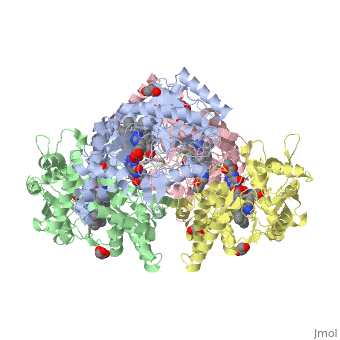Nos1
From Proteopedia
(Difference between revisions)
| Line 13: | Line 13: | ||
== Function == | == Function == | ||
| - | + | NOS1 is a major component of the production of Nitric Oxide which Nitric Oxide has important roles in the CNS. Nitric Oxide targets NO receptors on G-cylcase as well as other Nitric Oxide specific receptors. NOS1 is an important component of synaptogenesis, long-term potentiation, neurotransmitter release and synaptic plasticity (Juliane Kopf,).NOS1 is coupled with N-methyl-D-Aspartate (NMDA) receptors in the post-synapse of cells, which allows to the processes to occur. The NMDA receptor binds to PSD95 which than binds to NOS1. After the complex is formed, NDMDA receptor mediated CA2+ influx now regulates the amount of Nitric Oxide is produced by NOS1 (Freudenberg, F., Alttoa, A. & Reif, A.) | |
| + | NOS1 also contributes in limiting increased oxidative stress in the myocardium, limits systolic and diastolic dysfunction and all prevent a failing heart. NOS1 regulates the reuptake of Ca2+ in sarcoplamisic reticulum (SR). NOS1is shown into the human coronary artery smooth cells and maintains of basal blood flow. NOS1 also controls the parasympathetic and sympathetic regulation of the heart (Zan, Y,H et al.). NOS1 is important in all functions that help regulate the cardiac muscles (Zan, Y,H et al.). The ability of Nitric Oxide to self regulate enables NOS1 to control all these major functions. In myocite relaxation, the Nitric Oxide produced by NOS1 facilitates SERCA to increase intracellular CA2+ because if the increase in PKA dependent PLN phosphorylation. NOS1 also regulates cardiac function by the Nitric Oxide produced targets not CA2+ dependent (Zan, Y,H et al.). | ||
== Disease == | == Disease == | ||
Revision as of 18:43, 13 April 2016
Your Heading Here (maybe something like 'Structure')
| |||||||||||
References
- ↑ Hanson, R. M., Prilusky, J., Renjian, Z., Nakane, T. and Sussman, J. L. (2013), JSmol and the Next-Generation Web-Based Representation of 3D Molecular Structure as Applied to Proteopedia. Isr. J. Chem., 53:207-216. doi:http://dx.doi.org/10.1002/ijch.201300024
- ↑ Herraez A. Biomolecules in the computer: Jmol to the rescue. Biochem Mol Biol Educ. 2006 Jul;34(4):255-61. doi: 10.1002/bmb.2006.494034042644. PMID:21638687 doi:10.1002/bmb.2006.494034042644
- ↑ http://www.uniprot.org/uniprot/P29475
- ↑ https://genome.ucsc.edu/cgi-bin/hgGene?hgg_gene=uc001twm.3&hgg_prot=P29475&hgg_chrom=chr12&hgg_start=117208141&hgg_end=117361777&hgg_type=knownGene&db=hg38&hgsid=489411231_AtAMFbhafu5PPfVVOajY2rxS7qge

